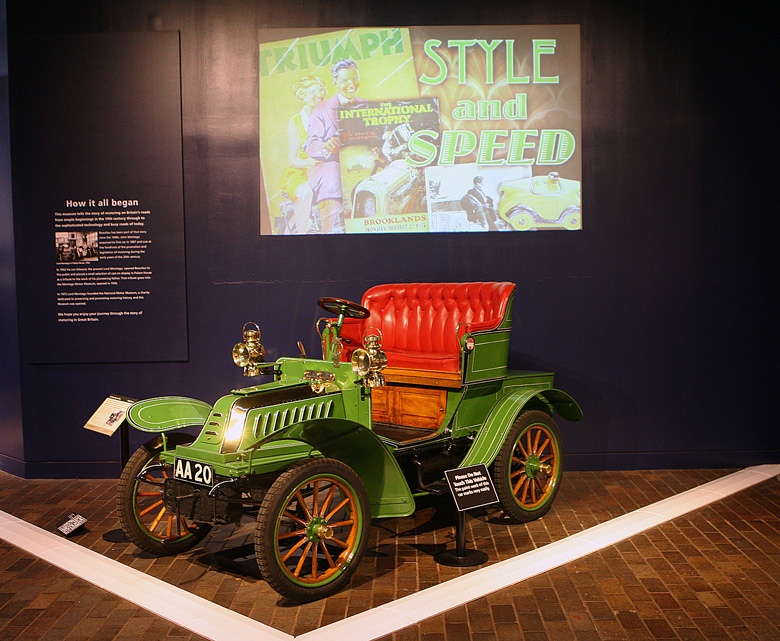
This 1903 single cylinder De Dion Bouton is still a regular entrant in the annual London to Brighton Veteran car run. The car was purchased by the Montagu family from a tenant on their estate in 1913 and was one of the five original cars that launched the Montagu Motor Museum in 1952 when the cars were displayed in the entrance hall of the family home.
Story and photos by Jonathan Sharp
Last week we mentioned that we would discuss the founder of the National Motor Museum, Lord Montagu. Here then, Jonathan Sharp does so as a prefix to Part 2 of the National Museum articles which will cover cars from A-L. Part 3 will show cars from L-Z and motorcycles. Part 4 will deal with the Land Speed Record Cars at the Museum. Ed.
Let’s get the elephant in the corner out of the room. In 1953 Edward, 3rd Baron Montagu of Beaulieu, together with two other gentlemen, was convicted of the then crime of a homosexual act with two other consenting adults, who turned Queen’s evidence. Lord Montagu served 8 months in prison. Such was the public’s disquiet as what was perceived to be the unfair victimization of a public figure and the criminality of sexual acts between consenting adults, that a public inquiry was finally set up which ultimately led to the law on homosexuality being reformed. Ok that’s out of the way.
Unfortunately, the sensational headlines from the 1950s still tend to obscure the many positive things achieved by Lord Montagu. Following his father’s death in 1928, Edward Montagu became a peer of the realm at the age of 2 and a half, Inheriting the Beaulieu estate when he turned 25. Educated at St Peter’s Court Broadstairs and Eton he joined the brigade of Guards and served in Palestine with the 3rd battalion. He later read modern history at Oxford. When working for the public relations company Voice and Vision he was involved with the launch of the much loved Eagle comic.
Inspired by Lord Bath opening his estate as a Safari park (remember the car sticker “I have seen the Lions of Longleat”?), and needing to raise funds to keep the estate which had been in the family since 1538, he decided to open Palace House to the public in 1952. The roots of the National Motor Museum grew from the five veteran cars that Lord Montagu first displayed in the entrance of Palace House on the Beaulieu estate. Over the years the collection of old cars grew and in 1959 the old school building on the estate was converted to house the collection. It opened as the Montagu Motor Museum by Lord Brabazon of Tara. Visitors continue to pour in so a new purpose-built building was constructed. Now named as the National Motor Museum, the building was opened by HRH the Duke of Kent on the 4th July 1972.
Lord Montagu loved to drive the cars of the collection; he rarely missed the annual London to Brighton Veteran car run, often taking Graham Hill, Bruce McLaren, Jim Clark or a well-known show biz personality as his passenger. He took part in the first Peking to Paris event driving a 1915 Prince Henry Vauxhall and also drove a 1914 Alpine Eagle Rolls Royce from Perth to Canberra crossing the longest stretch of straight road in the world known as the Nullarbor plain with HRH Prince Michael of Kent. When Dunlop announced in 1962 that it would cease production of tyres suitable for old cars, Lord Montagu and Philip Pollock formed Vintage Tyre supplies Ltd which is now the largest supplier of tyres for veteran and vintage cars thus keeping thousands of vintage cars active and on the road. The author of various motoring books Lord Montagu also loved jazz; the 1960 Beaulieu Jazz festival, attended by over 20,000 people but ultimately ended in a riot. He played a crucial role in the foundation of the Historic House Association and in 1984 became the first chairman of English Heritage. He was known as a fantastic host and his house parties were legendary often attend by the likes of Peter Sellers and Brit Ekland, Spike Milligan, the Osmonds whose fans invaded the house, and many more. On his 70th birthday he handed over the day to day running of the estate to his son from his first marriage Ralph. Lord Montagu died on the 31st August 2015 and was succeed by Ralph and survived by his second wife Fiona, his daughter and a second son.
Below, we continue our walk through the Museum, covering cars from A to L.
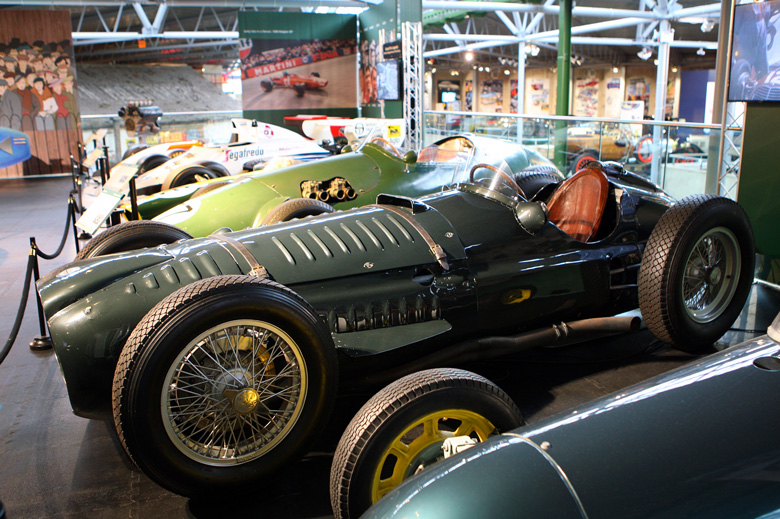
A glorious noise, but a alas a glorious failure despite the efforts of Moss, Fangio and Hawthorn. The 1950 BRM Type 15 Mk1 had a 1500cc supercharged V16, 500 bhp. It is displayed complete with the wonderful sound track playing in the background.
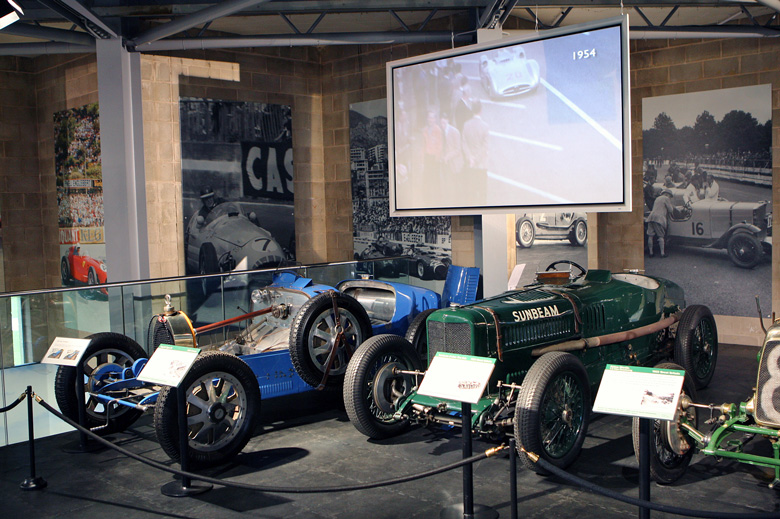
Bugatti T35 and Sunbeam
One of five Bugatti T35’s built for the 1924 French Grand Prix held at Lyon in August. This example carried the race number thirteen, in the hands of Ernest Friderich finished in 8th place despite a mid-race crash. In September the car was driven at San Sebastian in both the Tourist Trophy and the Spanish Grand Prix to sixth place by Ferdinand De Vizcaya.
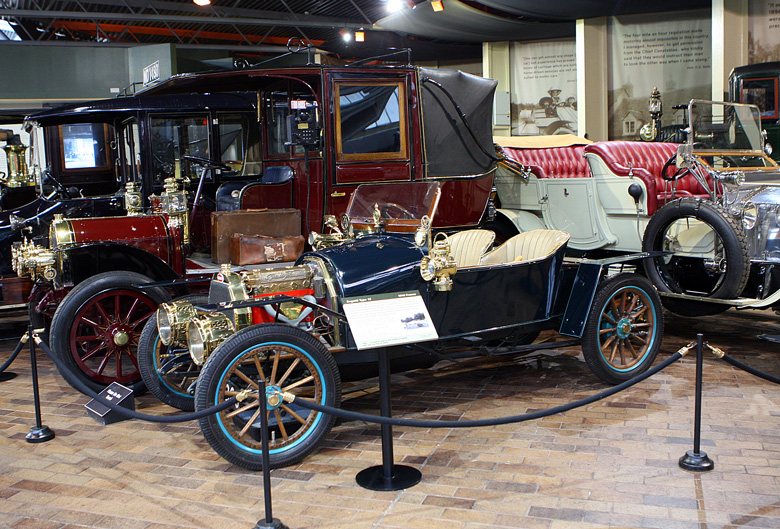
Dating from 1910 the 1327cc 4 cylinder Bugatti Type 15 is the longer wheel base version of the Type 13. This example is believed to have once been owned by the Bugatti family and is reputed to have been used on the Western Front during WW1. Originally fitted with a saloon type body by Wiederkehr of Colmar the current two seater sports body was fitted following the importation of the car into the UK around 1920. This is the oldest Bugatti in the UK and is believed to be the second oldest surviving Bugatti in the world.
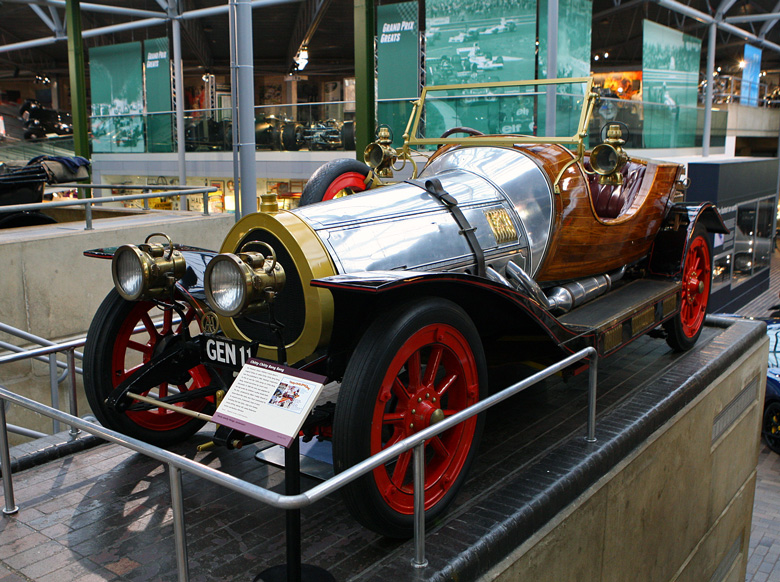
Our fine four fendered friend was the creation of the author Ian (James Bond) Fleming. The name was inspired by Count Zbrowoski’s Brooklands racer of the 1920’s Chitty Bang Bang. Children’s author Roald Dahl adapted the original story for the big screen and the film was produced by Albert “Cubby” Brocoli. Four examples were built for the film using the engine and gearbox of a Ford Zodiac by none other than Alan Mann racing.
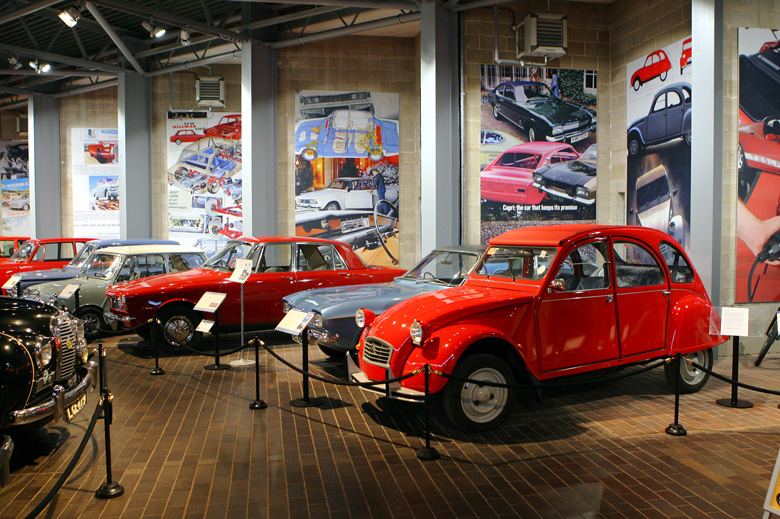
For the farmer, the lad about town and the bank manager. The 1986 Citroen 2CV6 has only covered 24 miles from new having been put straight into storage upon purchase. The Ford Capri 1600 L dates from 1971 and has covered less than 67000 miles, has never been driven on a motorway and rarely over 40 mph. The Rover 2000 dates from 1967 and has only had one owner from new.
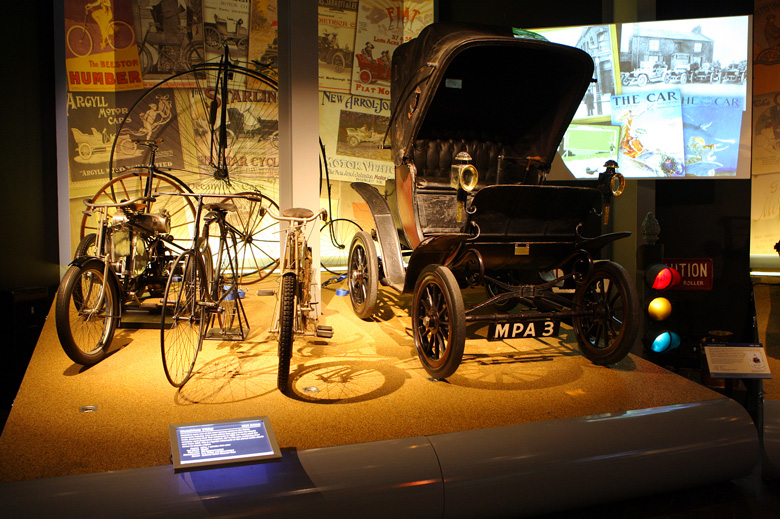
Electric vehicles are nothing new. This 1901 Columbia Electric was originally purchased by Queen Alexandra for driving around the grounds of Sandringham House the Royal residence in Norfolk on England’s East Coast. To warn of her silent arrival she had a foot operated bell fitted rather than the more normal horn. The car was purchased in the 1930s by RGJ Nash for his collection at Brooklands. He would drive the car regularly when petrol was later rationed.
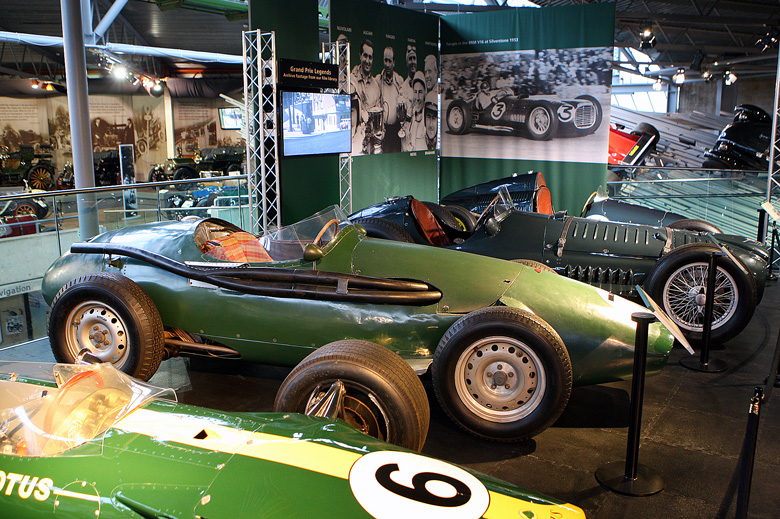
Connaught B Type chassis B6 was constructed in 1955 for Piero Scotti, an Italian soft drinks manufacturer who proceeded to race the car but met with little success. The car was then returned to the Connaught factory and in 1957 when the company folded the chassis passed into the hands of the Science Museum. It remains in very original condition. Tony Brooks met with more success in a Connaught B Type driving chassis B1 to victory, and fastest lap, at the 1955 Siracusa Grand Prix and defeating the works Maserati team to boot.
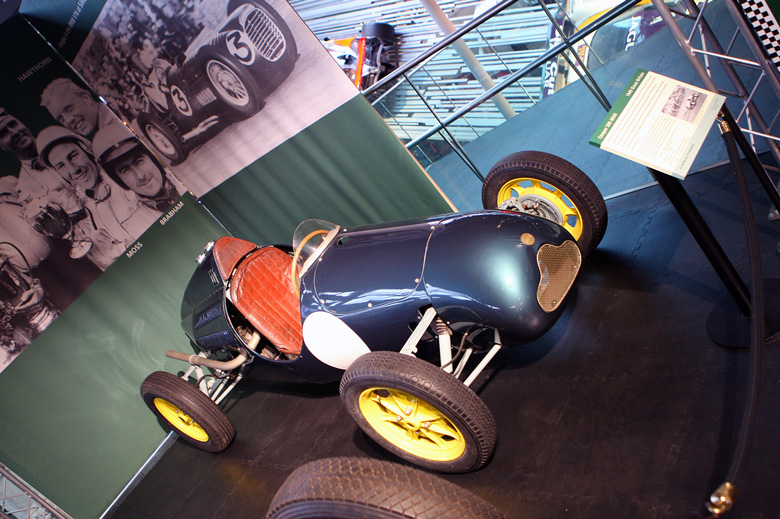
This Cooper 500 MK3 dates from 1949 and makes an interest contrast with the ultra complicated, and very expensive V16 BRM displayed next to it. Up until the founding of the 500 club in 1945 Motor racing had always been a rich man’s sport. Charles Cooper provided that by welding the front ends of two Fiat Topolino’s together and fitting a 500cc JAP Speedway motorbike engine a winning racing car could be made for just £150.

By 1984 Turbo engines ruled the Formula One roost and the Cosworth DFV was no longer competitive. The Ford Tec V6 turbocharged engine, or Cosworth GBA was the Ford Motor company’s response. Originally supplied to the Haas Lola team in 1986 the performance was less than satisfactory. In 1987 the engine supply was switched to the Benetton team and following more development the two Benetton drivers Thierry Boutson and Teo Fabi often finished in the points. At the end of the 1987 season Turbo engines were banned.
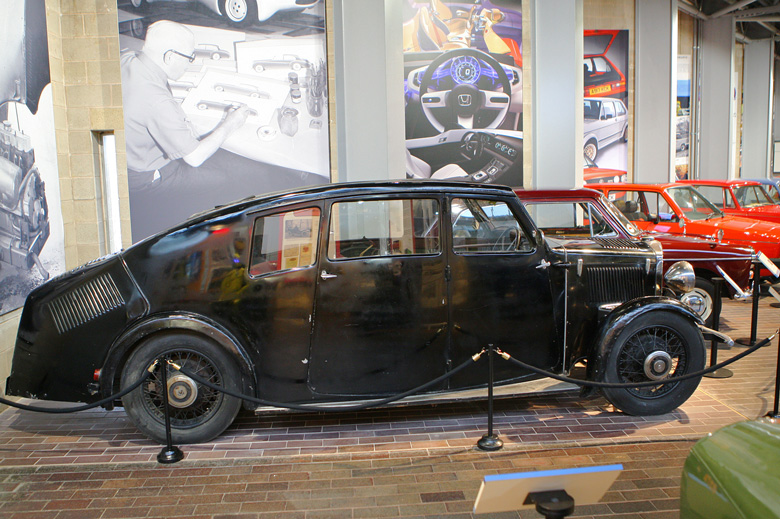
Sir Dennis Burney, one of the instigators in the design and construction of Sir Barnes Wallis’s Airship R100, was also responsible for the concert behind the design of the Burney Streamliner, a very unorthodox rear-engined streamlined motor car. This example was constructed in 1934 by Crossley Motors. Of the 25 built it is believed only three survive. The 1991cc 6 cylinder inline engine propelled the streamliner to a top speed of around 80 mph. Tricky handling hampered sales.
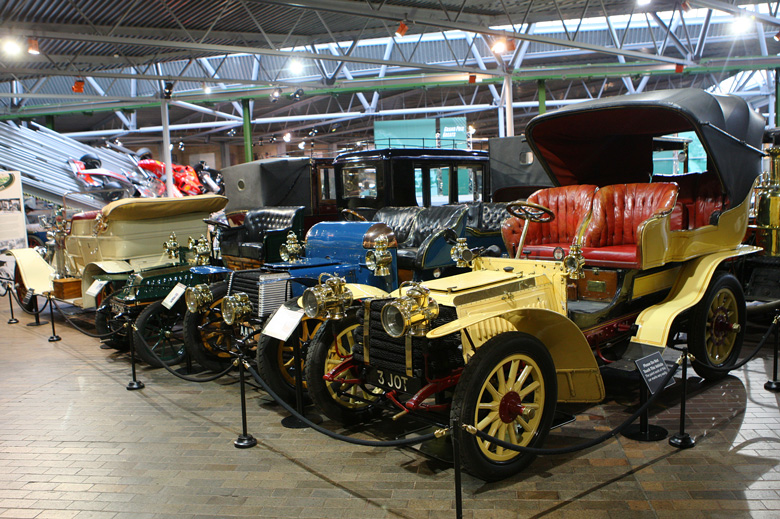
This 1903 24 hp 4 cylinder De Detrich, originally belonged to Sir Joseph Robinson, a gold mining Pioneer. The car was stored between 1910 and 1956 in a London furniture depository before being resurrected.
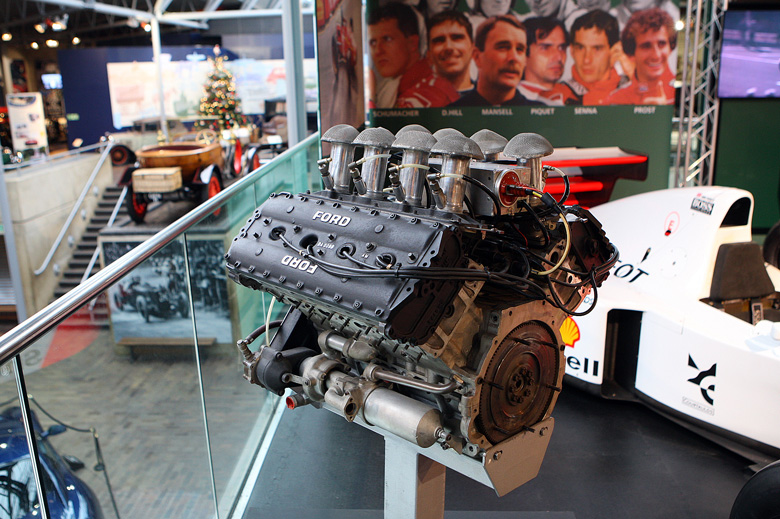
The mainstay of the Garagisti F1 teams from the late 60s, the supposedly cheap-as-chips Ford Cosworth Double Four Valve DFV.
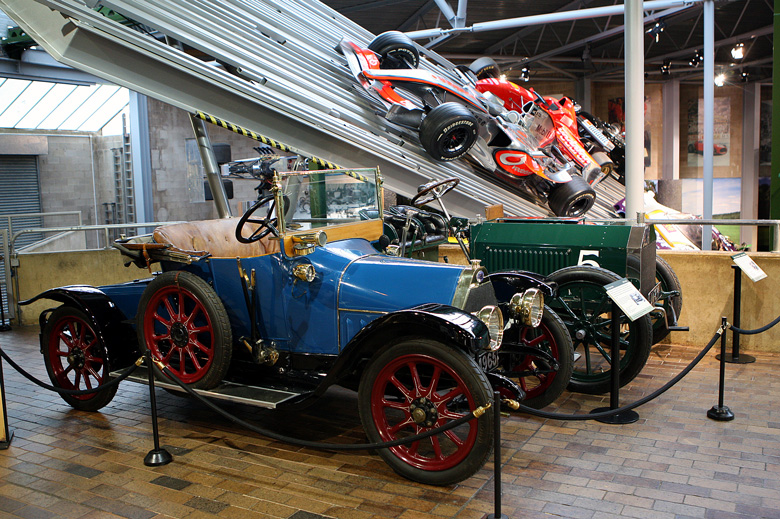
Fiat built approximately 2000 Tipo Zeros between 1912 and 1915. This example dating from 1913 is fitted with coachwork by Farina complete with a dicky seat for two children at the rear. In 1917 electric lighting and larger wheels were fitted and the car remained in use for a further 40 years and was driven by a Mr A Prime in trials events during the 1930s including the London to Edinburgh, Exeter and Lands End trials in 1933. The car later went on to serve as a garage tow vehicle until 1951. The vehicle behind the Fiat is a 1903 Napier Gordon Bennett racer which we featured a few years ago during her participation in the London to Brighton.
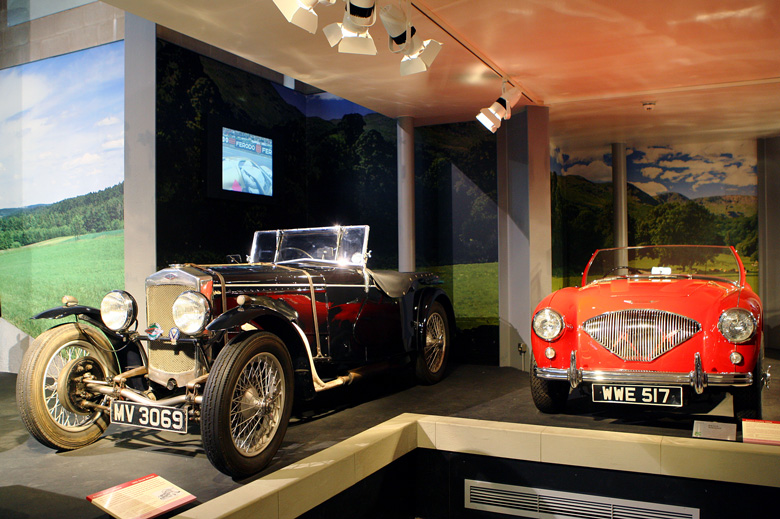
This 1496cc 4 cylinder Frazer Nash Colmore dates from 1932. In that year a sister car to this example won the highest possible award in the International Alpine Trial, the Coupe des Glaciers. The same car then went on to record an average speed over the hour of 85.43 mph at the Brooklands MCC High Speed Trials. In 33 years of production a little over 400 examples of the various models of Frazer Nash were built. Next to the Colmore is a 1955 Austin Healey 100M that was originally supplied to the late Earl of Wharncliff who used the car to complete in hill climbs and other sporting events before suffering a major accident whilst driving another car. The specification of the 100M model is very similar to the 1953 Le Mans cars.
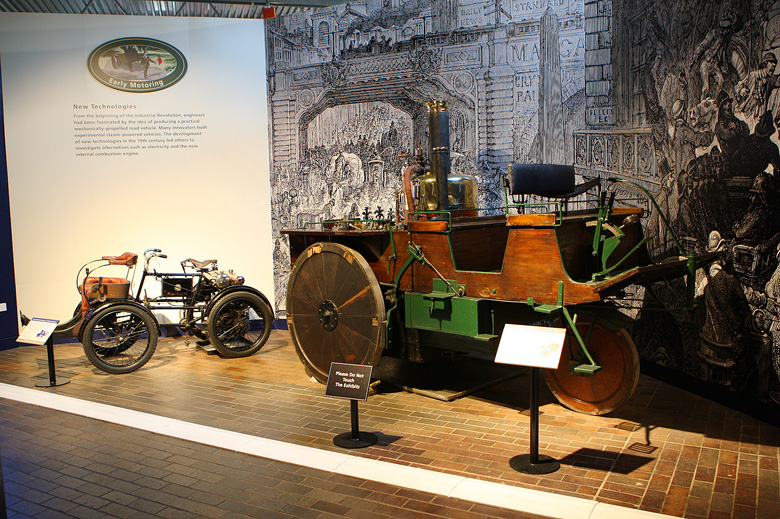
Five gallons a mile, of water that is, and 6 lb of coal as well. The Grenville Steam Carriage was constructed over a 15 year period around about 1875 by Robert Grenville. Robert was assisted by George Churchwood who went on to become the chief mechanical engineer of Gods Wonderful Railway better known as the Great Western Railway. The steam carriage could carry up to four passengers plus the driver and the fireman who sat on a small seat in the engine compartment at speeds up to 20 mph. It is believed that this is the oldest self-propelled passenger carrying vehicle still in working order.
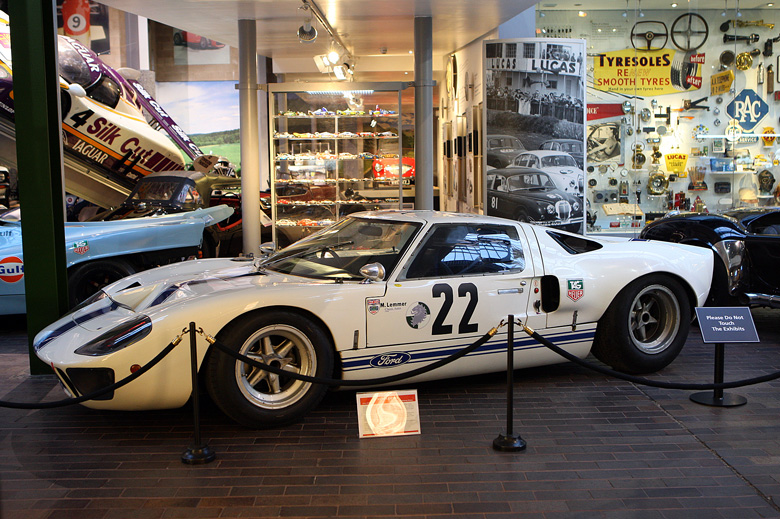
A new arrival at the museum at the time of my visit was this 1966 Ford GT40, chassis 1071. Piers Forrester, the original owner, used the car on the road and also in club races. Chassis 1071 was also featured in a comparison road test against a C Type Jaguar in a 1971 issue of Motor Magazine.
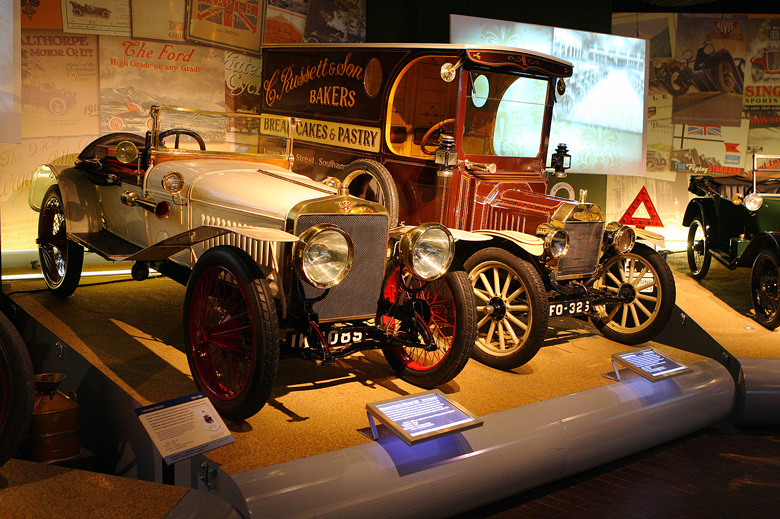
This Hispano is named Alfonso XIII in honor of Hispano Suiza’s most illustrious customer, King Alfonso XIII of Spain. This 4 cylinder 3615cc example dates from 1912 and is believed to be one of only three such examples in the UK. Close examination of the steering wheel rim will reveal damaged caused by a ricocheting bullet which killed the then owner during the Irish Rebellion of 1916. Parked next to the Hispano is a 1914 Ford Model T Van. This example is fitted with the £15.00 option of a starter and light.
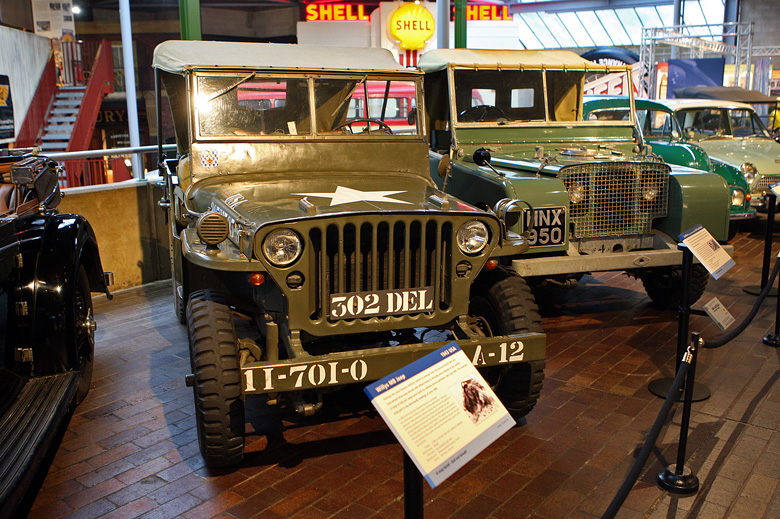
One begat the other; the Willys Jeep dates from 1943 and is a D-Day landing veteran. Later rebuilt by the French Army, the Jeep was brought to the UK in 1978 and is used on various military rallies and has returned to the beaches of Normandy on many occasions. Next to the Jeep is Land Rover R 04. R because it is in right hand drive, and 04 because it was the fourth pre production model built. This is one of the oldest surviving examples in the world. The prototype Land Rover was built to the design of Maurice and his brother Spencer Wilks using a combination of Jeep and Rover parts. On this example the front bumper forms part of the chassis rather than being bolted on as was the case with later examples. Early examples were mainly painted sage green using war surplus paint usually used on the interior of aircraft cockpits.
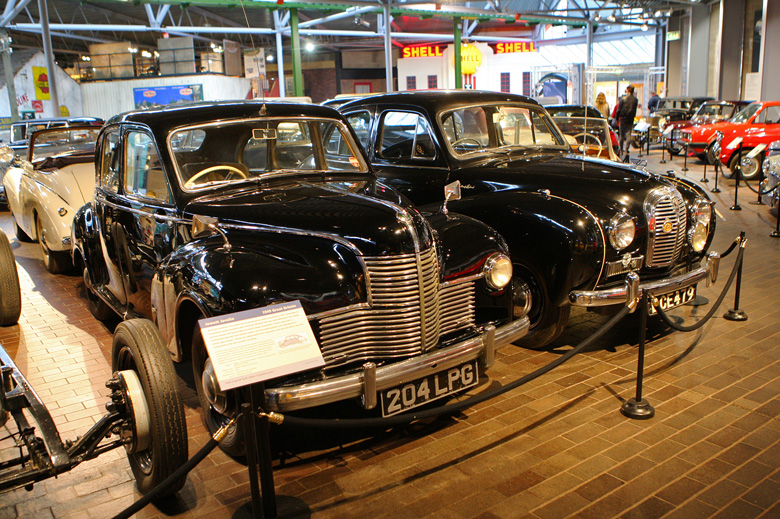
This 1949 Jowett Jupiter has been a resident of the museum since 1968. The Javelin’s design was very different to previous Jowett models. The lightweight and rigid unitary chassis body construction, high gearing and good aerodynamics gave the Javelin a higher than average cruising speed. The horizontally opposed 1486cc 50 bhp engine did however make regularly maintenance more difficult. It was easier to change the spark plugs by removing the front wheels. Parked next to the Javelin is the much more conventional 1953 A40 Austin Somerset. This is a one owner low mileage example which is still occasionally used. In 1952 the Somerset replaced the A40 Devon which had entered production in 1948. The Somerset offered more interior space, higher performance due to the fitted of the A40 Sports Special cylinder head and leather trimmed Dunlopillow upholstery rather than sprung cushions.
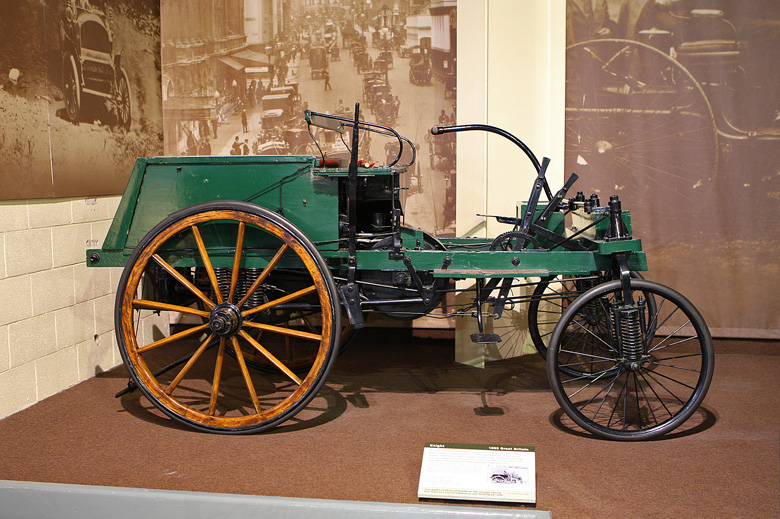
Shown at the 1896 Crystal Palace Motor Exhibition this 1895 Knight is believed to be the first British purpose built petrol powered vehicle to be driven on the public highway. Built by JH Knight originally as a three wheeler the 1565cc single cylinder engine powered the car to a top speed of 8 mph. In October 1895 John Knight with his assistant James Pullinger were stopped by the policy in Farnham high street and fined 15 schillings (75p) plus 10 shillings cost (50p) for not having a traction engine license and for not having a man walking in front of the car, the first motoring offence in Great Britain.
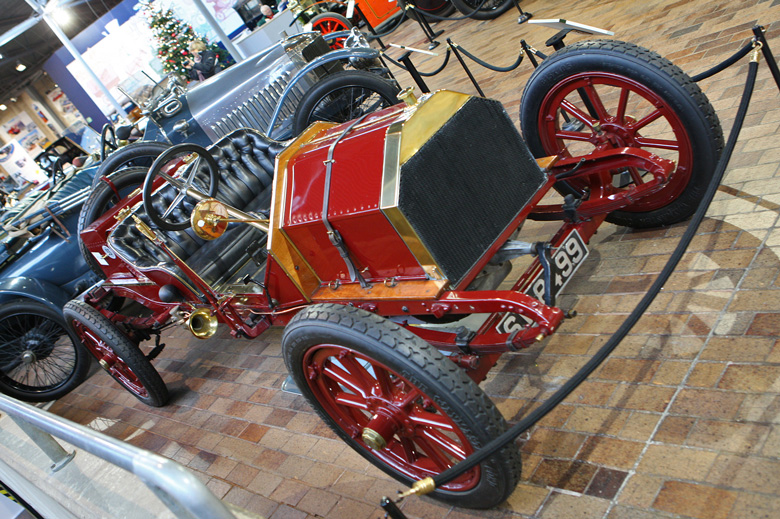
Built in 1910 and shipped new to Lancia’s USA distributor, this Lancia Corsa had a short racing career in the hands of Billy Knipper who drove it in the Massapequa Sweepstakes on Long Island on the 1st October 1910. He then went on to win the Tiedeman Trophy at Savannah on the 11th November. The Lancia then passed into private hands and was used for a time by the Fire Chief of Lenox Massachusetts to attend fires, and then later as a garage recovery vehicle.

Lotus Type 49 Chassis R3 is the sole surviving team car from the 1967 season. One of 12 built chassis R3 was assembled overnight on the eve of the British Grand Prix and then driven by Graham Hill in the race and for the rest of the season. The car was then sold shortly after the 1968 South African Grand Prix to privateer John Love and continued to be raced for many years. Restored in 1982 R3 came to the museum in 1985.
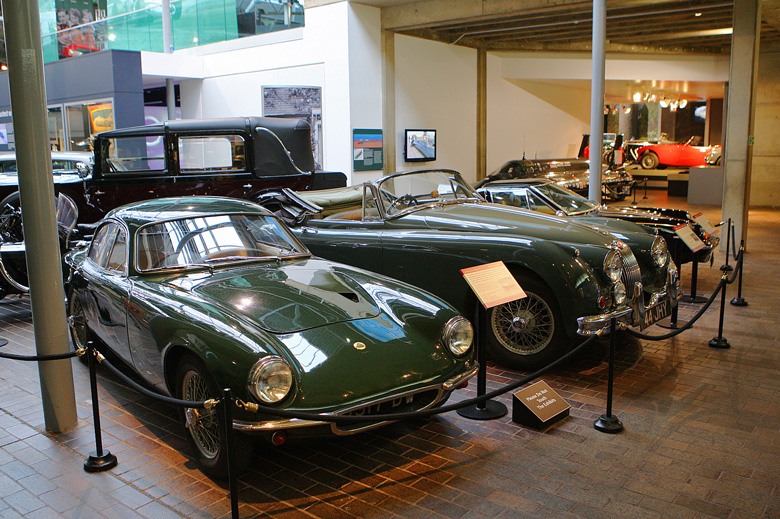
Technically advanced, featuring a fiber glass monocoque built from just three moldings, the Lotus Elite was good looking, great handling and successful on the race track. But not very reliable and Lotus lost a £100 on everyone they sold. This example dates from 1961 by which time you could purchase the car in kit form which avoided having to pay purchase tax. The factory said you could build it in 24 hours!. Next to the Elite is a 1960 Jaguar XK150; if you could not afford a new Ferrari 250 GT at £6326 the XK could be yours for just £2035.
Next week: M-Z and motorcyles
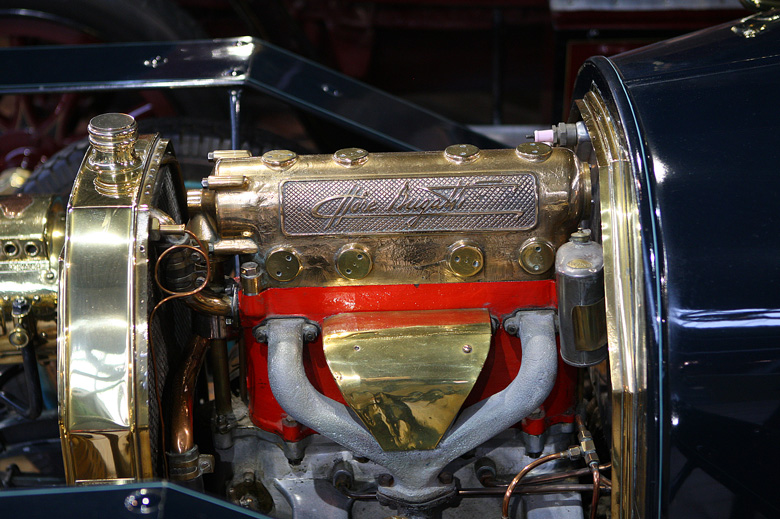
Thank you for this interesting series on Beaulieu and LM. A national treasure and a place that always enjoyable to spend a number of hours as there is so much to see and take in at the entire estate. My last visit was just after LM passed and they were preparing for the services so a subdued time.
I would highly recommend staying at the hotel on the grounds across from the museum. I’ll never forget awaking to the sound of supercharged pre-war Alfa’s, the Italian Club was driving in for a meet. A must visit for any enthusiast.
I visited the embryonic Museum, in 1952, as a 14 y.o. schoolboy. A budding photographer, with my very first camera, I am pleased to show you the Humber, one of the five mentioned, in Palace House. Re-registered HPC190 for his Lordship’s first wife, Belinda Crossley’s use, this was the start of the museum.
http://www.rick-ford.co.uk/humberetteMOD.jpg
Much interesting factual background to enhance the photos of fine vehicles, but a slight correction if I may, ref. the piece on the Grenville Steam Carriage. The CME of the GWR was George Jackson Churchward (not Churchwood) – a minor point, but as he is such a major figure in British railway history we should at least get his name right.
It is a wonderful collection of cars and motor homes. I have been there twice and fascinated on both visits.